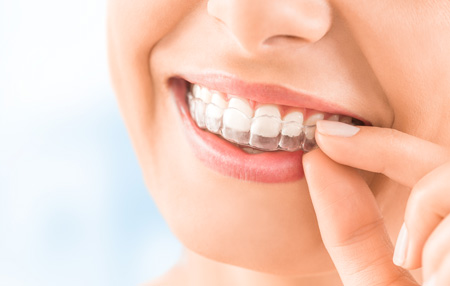How Does Invisalign Work? Do Clear Braces Actually Work?
 If braces, retainers or some other orthodontic treatment is something you are interested in, you are not alone. Almost one in ten Americans struggle with a severe overbite and millions more struggle with milder cosmetic problems such as crowded teeth, gap teeth, and underbites and a trip to the orthodontist is needed.
If braces, retainers or some other orthodontic treatment is something you are interested in, you are not alone. Almost one in ten Americans struggle with a severe overbite and millions more struggle with milder cosmetic problems such as crowded teeth, gap teeth, and underbites and a trip to the orthodontist is needed.
In fact, on any given day, about four million Americans wear braces. As for teenagers, the process is almost treated as a rite of passage of sorts, although it does come with its fair share of downsides.
Not only are braces known for causing aching in the gums and mouth and require frequent appointments, but they also require certain lifestyle changes, such as staying away from certain foods that can cause damage to the metal wires and elastic bands used in braces.
There is also one key factor that has led to many patients looking for an alternative: the appearance of braces (or, rather, the disappearance). It is obvious when a person wears braces or a retainer and this can be especially unappealing to adults, especially those in a professional capacity.
If you want an invisible or at least less prominent solution to your uneven teeth, there are three leading options available on the market: Invisalign, ceramic braces, and linguistic braces that are placed behind rather than in front of the teeth.
But what makes these options different and, more importantly, are they effective?
Invisalign Vs. Invisible Braces
Invisalign is a trademark for clear aligners that fit over your teeth almost like a retainer (although aligners take up a lot less space in your mouth). They are an alternative to braces but are typically worn for the same period of time—anywhere from a few months to over two years, depending on individual needs.
Invisalign is not actually one single device but multiple aligners that will be switched out as time goes on and your teeth begin to shift. Patients can expect to go through anywhere from 18 to 30 aligners by the time their treatment plan is finished.
An aligner is completely smooth and clear, meaning not only is it invisible, but it comes without the metalwork that is often associated with braces, such as brackets and wires. Additionally, you are able to remove your aligners to eat and brush your teeth, meaning your lifestyle and hygiene routine does not need to be adjusted.
Invisible braces, however, are just different forms of traditional braces. One popular choice is ceramic braces. The core difference with ceramic braces is that the brackets are made from material that is intended to blend into the white enamel of your teeth. Although they tend to work faster than Invisalign, they are not invisible as much as they are less noticeable than metal braces.
Linguistic braces are a form of metal braces where the brackets and wires are placed behind the teeth. This makes it invisible from onlookers but comes with a set of challenges. They are often harder to maintain than both aligners and traditional braces and many people notice increased discomfort. It could also make it more difficult for your dentist to make adjustments during your appointments.
All three forms of braces are associated with higher costs than metal braces, although the price will ultimately depend on your specific circumstances.
The Effectiveness of Invisalign and Invisible Braces
The good news is that all three options can offer an effective, less noticeable alternative to traditional metal braces.
Some research has shown that Invisalign is not quite as effective as traditional braces, although this is not to say that the treatment does not have its own merits. Although it might not be best-suited for severe cases, many patients are able to benefit from Invisalign. Additionally, Invisalign may take longer than metal braces.
Like conventional braces, linguistic and ceramic braces are very effective (and often quicker) options, and better suited for patients who need more intensive treatment to improve their bite and teeth alignment.
Choosing Between Invisalign and Braces
Choosing between braces and Invisalign can be a hard decision and should not be made until after you have visited your dentist and discussed your options. Ultimately, your doctor can help you decide which treatment option is best for your own needs. Here are some additional factors to consider:
- Your Budget: Can you afford the higher costs associated with ceramic and linguistic braces or Invisalign?
- Your Insurance Coverage: Does your insurance cover just braces or Invisalign as well? How much of the cost is covered?
- Your Medical Needs: Does your dentist believe Invisalign will be effective or do braces seem to be the most effective route?
- Appearance: How important is it to you for your orthodontic work to be invisible? Is it relevant to your career? (i.e. do you work in a field where wearing braces may be seen as unprofessional?)
- Comfort: Invisalign is typically known to be the more comfortable option as it comes without wires, brackets, and metal
- Lifestyle changes: Are you willing to give up certain foods in the long-term?
- Timing: How long will you need braces? How will this time frame change with Invisalign?
Finding a Provider
Before you can find out whether braces or aligners are right for you, you must first find the right dentist or orthodontist in your area.
That’s where we can help. We operate a completely toll-free, 24-hour hotline at 1-(855)-282-1699, where we can help you find a dentist that can cater to your specific needs wherever you live in the country. It’s an entirely free service—the only thing we want is to help you find the best dentist for your family. You can also visit our website to learn more about the services we offer.
It’s OK if the idea of committing to braces for months to even years is nerve-wracking, especially when you consider their obvious appearance. Fortunately, with support from the right dentist, you can make an informed decision that will help you get the clear teeth you want, without the appearances and hassle of conventional braces.
There is no correct answer to this question. cialis south africa price Which one you choose depends on your health and how often you intend to use the treatment.
Medically Fact-Checked & Written by Our Dental Editorial Team
You can read more about our editorial guidelines by clicking this link and learn more about the Emergency Dentists USA editorial team here.



